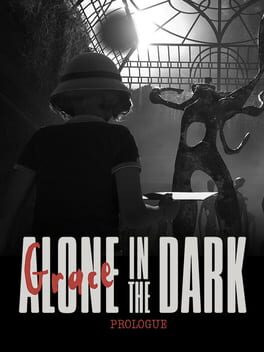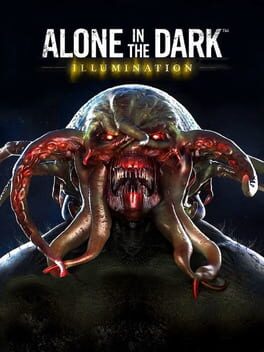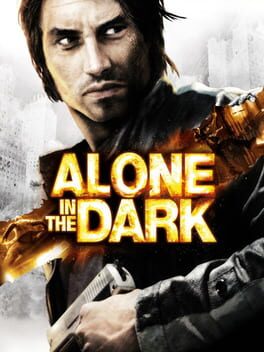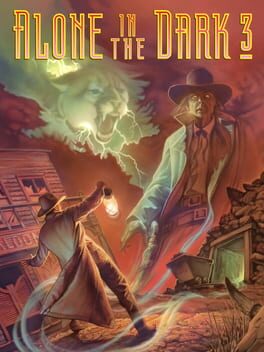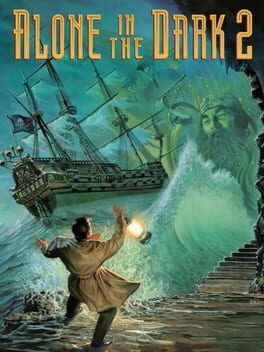

Alone in the Dark: The New Nightmare, alternatively known as Alone in the Dark 4, is the fourth installment of the survival horror video game series Alone in the Dark, developed by Darkworks and published by Infogrames. The game was released in 2001 in North America and Europe on several platforms including Microsoft Windows, PlayStation, Dreamcast, and Game Boy Color. The PlayStation 2 version of the game was released only in Europe. It was followed in 2008 by Alone in the Dark. As of October 29, 2013, the game was released on Steam.
Also in series
Reviews View More
You can say a lot of things about the other Alone in the Dark games, many of them negative, but at least they're memorable and creative to a fault. New Nightmare is one of the dullest, least unique games I've ever played. It doesn't have a single original idea, except for maybe the flashlight mechanic, which is completely pointless after the first 15 minutes of Aline's scenario. This would be fine if it executed any of its gameplay or story elements well at all, but it doesn't. A genuinely boring experience with writing and combat that could be mistaken for a sleep aid.
The original Alone in the Dark, while certainly not the first survival horror, planted the seeds for which the genre would soon flourish. The story goes that it served as direct inspiration for the original Resident Evil, which would then define and popularize what survival horror was and would be for the next few years. Where, then, does that leave Alone in the Dark, having not had another release since the underperformance of Alone in the Dark 3? Reinvigorated, apparently. The success of Resident Evil brought forward a slew of other studios trying their hand at survival horror, one amongst their number Infogrames, the original developers for Alone in the Dark, who hired developer Darkworks to capitalize on its status of fathering many of the things that Resident Evil went on to popularize. This… was loosely a double-edged sword, however. While it is true that many particular aspects — the mansion setting, giving their player a choice of two different campaigns to go through — were things originally devised by Infogrames, Alone in the Dark: The New Nightmare ends up feeling more like Resident Evil than any of its survival horror contemporaries, and in some ways feels like an imitation: a comparison that does not lend New Nightmare any particular favours.
New Nightmare imagines itself a reboot of the original Alone in the Dark, and as part of that, reimagines the series for the (at-the-time) modern day. You have the choice of playing as either Aline Cedrac, a young university professor searching for her missing father (a spiritual successor to the original Alone in the Dark’s female PC, Emily Hartwood), and Edward Carnby, a private investigator and possible descendant of the Carnby you played in the three AitD games preceding. When Carnby’s close friend winds up dead after attempting to investigate mysterious goings on at Shadow Island. Teaming up with Aline to investigate, their attempt at approaching the island is foiled as their plane crashes, leaving both separated as it soon becomes clear there are dangerous forces on Shadow Island. Regardless of whether you're Aline or Carnby, it’s up to whoever you pick to reunite yourself with the other character, find out the goings on of the island, and try and stop the Morton family, and their attempts to bring about the... "World of Darkness(c)."
The game does a decent job of making both these campaigns feel distinct from each other. While it doesn’t particularly matter doing both, or which one you do first — ala Resident Evil 2’s Leon/Claire A/B routes — the game you play is considerably different depending on who you choose to play as in the beginning. Each character takes a separate path through the game, does different things at different times, and goes through whole areas the other player character doesn’t, up to the point where both main characters have different final areas and bosses. Playing as Carnby hews a bit closer to your traditional survival horror experience: you’re given ammo from the start, you’re able to scrounge for resources, you must solve puzzles and fight increasingly tough enemies in order to find your way out. Aline, however… plays loosely like a proto ObsCure. Emphasis on loosely: because she’s a woman Aline doesn’t get to start with weapons like Carnby does, and instead must use her flashlight to repel monsters, either to kill them directly, get enough distance for you to get out of the room, or for you to find the lightswitch and instantly kill everything in the room. It’s… rather clunky in execution (and the game does go back to familiar survival horror tropes after a certain point, giving you weapons and pitting you against a Nemesis-like recurring boss) but I love there’s a concerted effort into making both characters feel different to play. Really works to add replay value (even if I was rather ready to call it quits once I’d gotten a cursory taste for how Aline played like), and it makes those moments of slight intersection — meeting the other character face to face, having them radio you what you need to do — a little bit potent, making you curious about what's going on in the other side of the story.
It’s a bit of a pity, otherwise, that this game doesn’t particularly iterate much on the formula it takes from. Or even particularly feel like its own thing. If you’ve played the original Resident Evil... you haven’t quite played Alone in the Dark: The New Nightmare, but you’re certainly not playing anything you haven’t played before. Again, it could merely be a consequence of how the original Resident Evil took inspiration from Alone in the Dark — and how any subsequent attempt to make a new Alone in the Dark would then provoke comparisons — but I think the real problem is that anything it does to stand out does not stand out for the better. Aline’s flashlight combat immediately shows how clunky it feels to use: feeling visually unclear whether your flashlight is damaging the enemy or merely forcing it to move, having to hold the flashlight in place for a long time before it kills the enemy/pushes it back far enough to matter, and enemies having long enough range that they can attack you from halfway across the room the moment you dare move the flashlight off them. Carnby (or even Aline, once she gets methods of fighting back) doesn’t fare much better: enemies freely, constantly respawn upon you killing them, which… is loosely horrible juxtaposed to the limited resources you’re capable of picking up. It’s never worth killing anything you theoretically could avoid, given they’ll come back the moment you re-enter the room, and eventually most rooms become flooded by enemies you’re just constantly running from. You have more ammo than you need to be able to get through everything, sure, but it doesn’t stop combat from feeling mostly irritating: fighting the same enemies again after going in and out of a room, getting hit an enemy spawned right in front of you when you entered a room, having to backtrack and having to duck and weave around every enemy on your way there and back.
There are other things that bog the experience down. The game goes rather overboard with its background lore: while previous Alone in the Dark games (and survival horror as a genre) were fond of their diary entries explaining the background lore, it never went quite so far as to give you any that was nearly 50 pages long. Nor do they ever tend to give three 15+ page diaries one right after the other. The game is kind enough to highlight any information you actually need to progress through the game but I feel like if the goal was for the player to understand the grander picture of what went on in the past that particular approach feels rather counterintuitive: if the player (especially someone who… rather struggles to learn via merely reading the information, like me) isn’t immediately compelled to skip it all under the sheer weight of how much there is to read, it’s rather difficult to retain anything in particular when it’s all dropped on you at once, and when it’s all in the midst of so many other things. The game feels… quite buggy and unfinished in places: there’s a boss I faced with Carnby, who, because I had happened to save in a specific room, would not go through its death animation upon reaching 0 HP unless you hit it during a certain part of its pattern, which caused me, at least, to reload the fight several times wondering what exactly I was doing wrong (not helped by the rather specific/non-indicative way of actually doing damage to it). The final area… is aesthetically interesting in how it jumps between several different biomes and inspirations, but is a total slog to play: throwing endless respawning enemies in your face as you wander through constant mazes all while you think ‘okay, this has gone on long enough, maybe the end is somewhat soon’ right before it gives you another maze for you to find the exit to. It’s mitigated, partially, because it gives you a gun that obliterates everything it comes in contact with and respawns ammo for it everywhere, but it’s rather clear just by spending what felt like a full hour inside it that it doesn’t feel quite as polished as the previous two acts of the game, and as a finale… is certainly the weakest point of the game.
Overall… this is honestly rather complicated to talk about. While I certainly do like the way the game utilizes its choice between which character you play as (and, in addition, what campaign you go through), it’s a bit hard to talk about how the game mostly… just feels like I’m playing a knockoff Resident Evil. Most of what it does competently is something I feel other games of the time did well, and the things that do differentiate itself from the pack… aren’t exactly fantastic. As a game meant to revive Alone in the Dark as a big name for the horror genre (the credits outright say “Edward Carnby will return”), The New Nightmare feels like a thing of the past compared to its contemporaries, and perhaps not the boost needed to bring the series into the modern day. 5/10. And while Darkworks’ attempts at a direct followup eventually became something else entirely, Edward Carnby did, eventually, return… for better or worse…
New Nightmare imagines itself a reboot of the original Alone in the Dark, and as part of that, reimagines the series for the (at-the-time) modern day. You have the choice of playing as either Aline Cedrac, a young university professor searching for her missing father (a spiritual successor to the original Alone in the Dark’s female PC, Emily Hartwood), and Edward Carnby, a private investigator and possible descendant of the Carnby you played in the three AitD games preceding. When Carnby’s close friend winds up dead after attempting to investigate mysterious goings on at Shadow Island. Teaming up with Aline to investigate, their attempt at approaching the island is foiled as their plane crashes, leaving both separated as it soon becomes clear there are dangerous forces on Shadow Island. Regardless of whether you're Aline or Carnby, it’s up to whoever you pick to reunite yourself with the other character, find out the goings on of the island, and try and stop the Morton family, and their attempts to bring about the... "World of Darkness
The game does a decent job of making both these campaigns feel distinct from each other. While it doesn’t particularly matter doing both, or which one you do first — ala Resident Evil 2’s Leon/Claire A/B routes — the game you play is considerably different depending on who you choose to play as in the beginning. Each character takes a separate path through the game, does different things at different times, and goes through whole areas the other player character doesn’t, up to the point where both main characters have different final areas and bosses. Playing as Carnby hews a bit closer to your traditional survival horror experience: you’re given ammo from the start, you’re able to scrounge for resources, you must solve puzzles and fight increasingly tough enemies in order to find your way out. Aline, however… plays loosely like a proto ObsCure. Emphasis on loosely: because she’s a woman Aline doesn’t get to start with weapons like Carnby does, and instead must use her flashlight to repel monsters, either to kill them directly, get enough distance for you to get out of the room, or for you to find the lightswitch and instantly kill everything in the room. It’s… rather clunky in execution (and the game does go back to familiar survival horror tropes after a certain point, giving you weapons and pitting you against a Nemesis-like recurring boss) but I love there’s a concerted effort into making both characters feel different to play. Really works to add replay value (even if I was rather ready to call it quits once I’d gotten a cursory taste for how Aline played like), and it makes those moments of slight intersection — meeting the other character face to face, having them radio you what you need to do — a little bit potent, making you curious about what's going on in the other side of the story.
It’s a bit of a pity, otherwise, that this game doesn’t particularly iterate much on the formula it takes from. Or even particularly feel like its own thing. If you’ve played the original Resident Evil... you haven’t quite played Alone in the Dark: The New Nightmare, but you’re certainly not playing anything you haven’t played before. Again, it could merely be a consequence of how the original Resident Evil took inspiration from Alone in the Dark — and how any subsequent attempt to make a new Alone in the Dark would then provoke comparisons — but I think the real problem is that anything it does to stand out does not stand out for the better. Aline’s flashlight combat immediately shows how clunky it feels to use: feeling visually unclear whether your flashlight is damaging the enemy or merely forcing it to move, having to hold the flashlight in place for a long time before it kills the enemy/pushes it back far enough to matter, and enemies having long enough range that they can attack you from halfway across the room the moment you dare move the flashlight off them. Carnby (or even Aline, once she gets methods of fighting back) doesn’t fare much better: enemies freely, constantly respawn upon you killing them, which… is loosely horrible juxtaposed to the limited resources you’re capable of picking up. It’s never worth killing anything you theoretically could avoid, given they’ll come back the moment you re-enter the room, and eventually most rooms become flooded by enemies you’re just constantly running from. You have more ammo than you need to be able to get through everything, sure, but it doesn’t stop combat from feeling mostly irritating: fighting the same enemies again after going in and out of a room, getting hit an enemy spawned right in front of you when you entered a room, having to backtrack and having to duck and weave around every enemy on your way there and back.
There are other things that bog the experience down. The game goes rather overboard with its background lore: while previous Alone in the Dark games (and survival horror as a genre) were fond of their diary entries explaining the background lore, it never went quite so far as to give you any that was nearly 50 pages long. Nor do they ever tend to give three 15+ page diaries one right after the other. The game is kind enough to highlight any information you actually need to progress through the game but I feel like if the goal was for the player to understand the grander picture of what went on in the past that particular approach feels rather counterintuitive: if the player (especially someone who… rather struggles to learn via merely reading the information, like me) isn’t immediately compelled to skip it all under the sheer weight of how much there is to read, it’s rather difficult to retain anything in particular when it’s all dropped on you at once, and when it’s all in the midst of so many other things. The game feels… quite buggy and unfinished in places: there’s a boss I faced with Carnby, who, because I had happened to save in a specific room, would not go through its death animation upon reaching 0 HP unless you hit it during a certain part of its pattern, which caused me, at least, to reload the fight several times wondering what exactly I was doing wrong (not helped by the rather specific/non-indicative way of actually doing damage to it). The final area… is aesthetically interesting in how it jumps between several different biomes and inspirations, but is a total slog to play: throwing endless respawning enemies in your face as you wander through constant mazes all while you think ‘okay, this has gone on long enough, maybe the end is somewhat soon’ right before it gives you another maze for you to find the exit to. It’s mitigated, partially, because it gives you a gun that obliterates everything it comes in contact with and respawns ammo for it everywhere, but it’s rather clear just by spending what felt like a full hour inside it that it doesn’t feel quite as polished as the previous two acts of the game, and as a finale… is certainly the weakest point of the game.
Overall… this is honestly rather complicated to talk about. While I certainly do like the way the game utilizes its choice between which character you play as (and, in addition, what campaign you go through), it’s a bit hard to talk about how the game mostly… just feels like I’m playing a knockoff Resident Evil. Most of what it does competently is something I feel other games of the time did well, and the things that do differentiate itself from the pack… aren’t exactly fantastic. As a game meant to revive Alone in the Dark as a big name for the horror genre (the credits outright say “Edward Carnby will return”), The New Nightmare feels like a thing of the past compared to its contemporaries, and perhaps not the boost needed to bring the series into the modern day. 5/10. And while Darkworks’ attempts at a direct followup eventually became something else entirely, Edward Carnby did, eventually, return… for better or worse…

